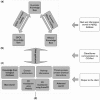GPCRs, G-proteins, effectors and their interactions: human-gpDB, a database employing visualization tools and data integration techniques
- PMID: 20689020
- PMCID: PMC2931634
- DOI: 10.1093/database/baq019
GPCRs, G-proteins, effectors and their interactions: human-gpDB, a database employing visualization tools and data integration techniques
Abstract
G-protein coupled receptors (GPCRs) are a major family of membrane receptors in eukaryotic cells. They play a crucial role in the communication of a cell with the environment. Ligands bind to GPCRs on the outside of the cell, activating them by causing a conformational change, and allowing them to bind to G-proteins. Through their interaction with G-proteins, several effector molecules are activated leading to many kinds of cellular and physiological responses. The great importance of GPCRs and their corresponding signal transduction pathways is indicated by the fact that they take part in many diverse disease processes and that a large part of efforts towards drug development today is focused on them. We present Human-gpDB, a database which currently holds information about 713 human GPCRs, 36 human G-proteins and 99 human effectors. The collection of information about the interactions between these molecules was done manually and the current version of Human-gpDB holds information for about 1663 connections between GPCRs and G-proteins and 1618 connections between G-proteins and effectors. Major advantages of Human-gpDB are the integration of several external data sources and the support of advanced visualization techniques. Human-gpDB is a simple, yet a powerful tool for researchers in the life sciences field as it integrates an up-to-date, carefully curated collection of human GPCRs, G-proteins, effectors and their interactions. The database may be a reference guide for medical and pharmaceutical research, especially in the areas of understanding human diseases and chemical and drug discovery. Database URLs: http://schneider.embl.de/human_gpdb; http://bioinformatics.biol.uoa.gr/human_gpdb/
Figures






Similar articles
-
Recent advances in computational studies of GPCR-G protein interactions.Adv Protein Chem Struct Biol. 2019;116:397-419. doi: 10.1016/bs.apcsb.2018.11.011. Epub 2019 Jan 3. Adv Protein Chem Struct Biol. 2019. PMID: 31036298 Free PMC article. Review.
-
gpDB: a database of GPCRs, G-proteins, effectors and their interactions.Bioinformatics. 2008 Jun 15;24(12):1471-2. doi: 10.1093/bioinformatics/btn206. Epub 2008 Apr 25. Bioinformatics. 2008. PMID: 18441001
-
A database for G proteins and their interaction with GPCRs.BMC Bioinformatics. 2004 Dec 24;5:208. doi: 10.1186/1471-2105-5-208. BMC Bioinformatics. 2004. PMID: 15619328 Free PMC article.
-
Predicting the coupling specificity of GPCRs to G-proteins by support vector machines.Genomics Proteomics Bioinformatics. 2005 Nov;3(4):247-51. doi: 10.1016/s1672-0229(05)03035-4. Genomics Proteomics Bioinformatics. 2005. PMID: 16689694 Free PMC article.
-
The G-protein coupled receptor family: actors with many faces.Curr Pharm Des. 2012;18(2):175-85. doi: 10.2174/138161212799040529. Curr Pharm Des. 2012. PMID: 22229577 Review.
Cited by
-
Proteomics-based methods for discovery, quantification, and validation of protein-protein interactions.Anal Chem. 2013 Jan 15;85(2):749-68. doi: 10.1021/ac3033257. Epub 2012 Dec 12. Anal Chem. 2013. PMID: 23157382 Free PMC article. Review. No abstract available.
-
GPCR-SSFE: a comprehensive database of G-protein-coupled receptor template predictions and homology models.BMC Bioinformatics. 2011 May 23;12:185. doi: 10.1186/1471-2105-12-185. BMC Bioinformatics. 2011. PMID: 21605354 Free PMC article.
-
Recent advances in computational studies of GPCR-G protein interactions.Adv Protein Chem Struct Biol. 2019;116:397-419. doi: 10.1016/bs.apcsb.2018.11.011. Epub 2019 Jan 3. Adv Protein Chem Struct Biol. 2019. PMID: 31036298 Free PMC article. Review.
-
Identification of G protein-coupled receptor signaling pathway proteins in marine diatoms using comparative genomics.BMC Genomics. 2013 Jul 24;14:503. doi: 10.1186/1471-2164-14-503. BMC Genomics. 2013. PMID: 23883327 Free PMC article.
-
HMPAS: Human Membrane Protein Analysis System.Proteome Sci. 2013 Nov 7;11(Suppl 1):S7. doi: 10.1186/1477-5956-11-S1-S7. Epub 2013 Nov 7. Proteome Sci. 2013. PMID: 24564858 Free PMC article.
References
-
- Oldham WM, Hamm HE. Heterotrimeric G protein activation by G-protein-coupled receptors. Nat. Rev. Mol. Cell. Biol. 2008;9:60–71. - PubMed
-
- Kolakowski LF., Jr GCRDb: a G-protein-coupled receptor database. Receptors Channels. 1994;2:1–7. - PubMed
-
- Kristiansen K. Molecular mechanisms of ligand binding, signaling, and regulation within the superfamily of G-protein-coupled receptors: molecular modeling and mutagenesis approaches to receptor structure and function. Pharmacol. Ther. 2004;103:21–80. - PubMed
Publication types
MeSH terms
Substances
LinkOut - more resources
Full Text Sources
Other Literature Sources
Molecular Biology Databases

